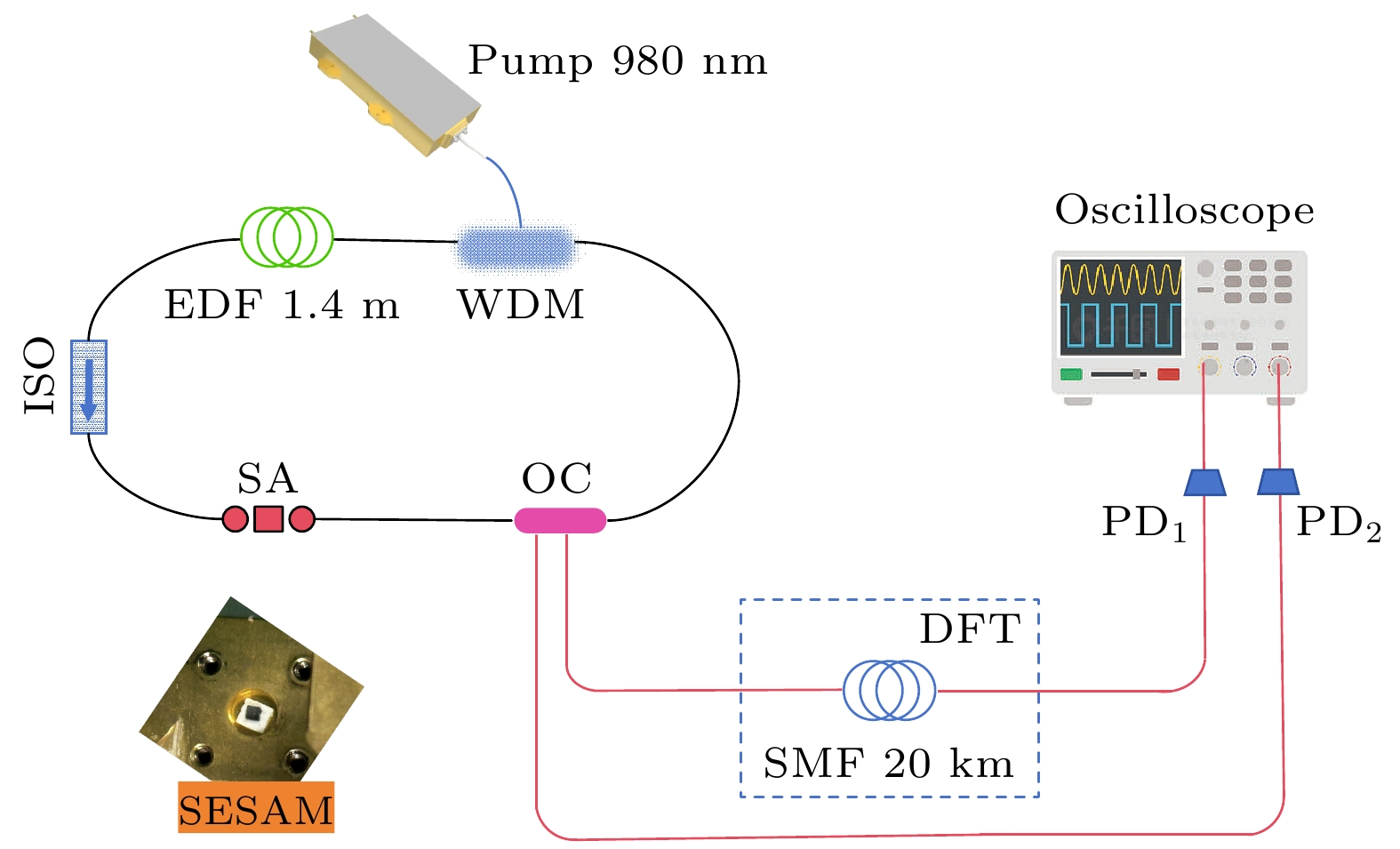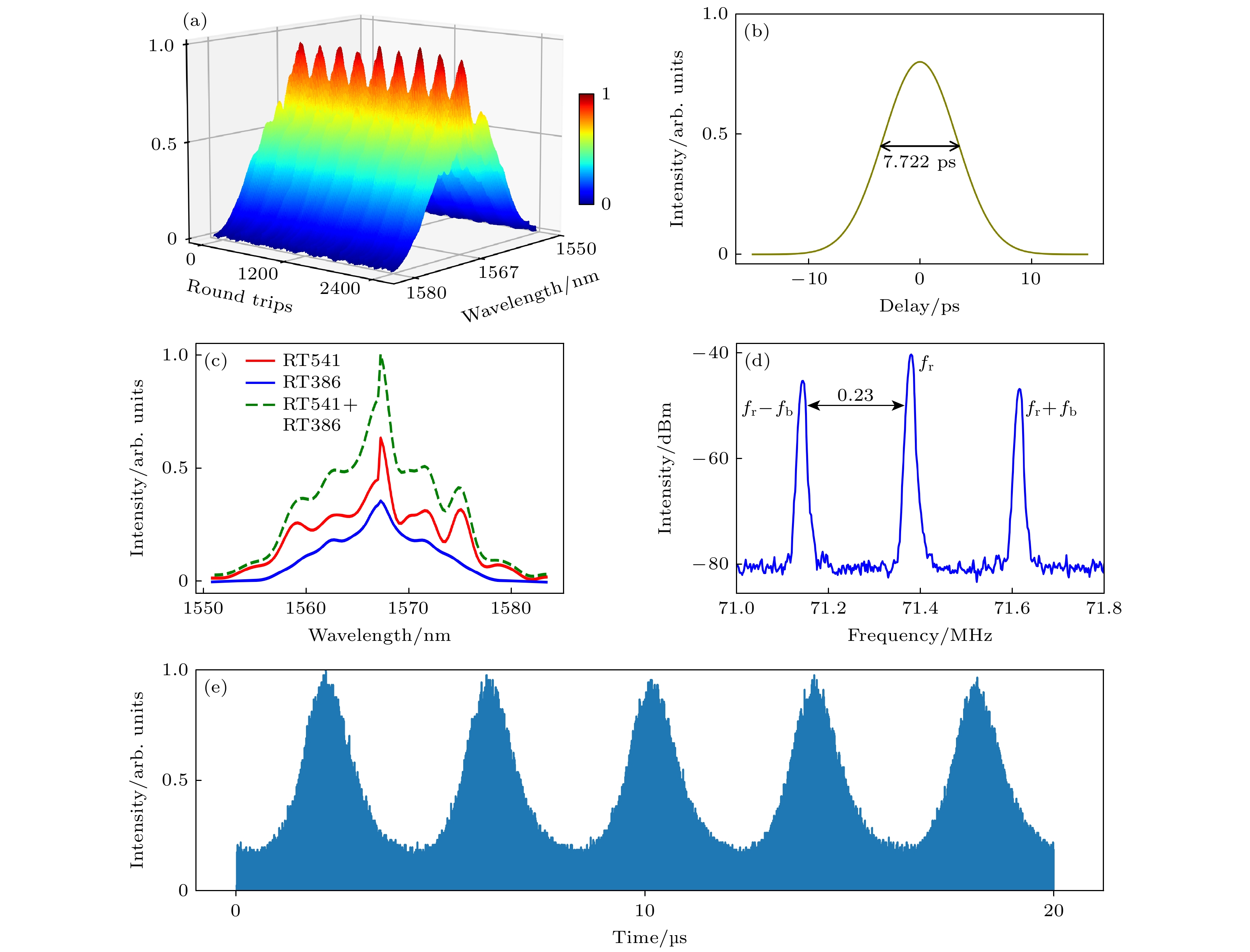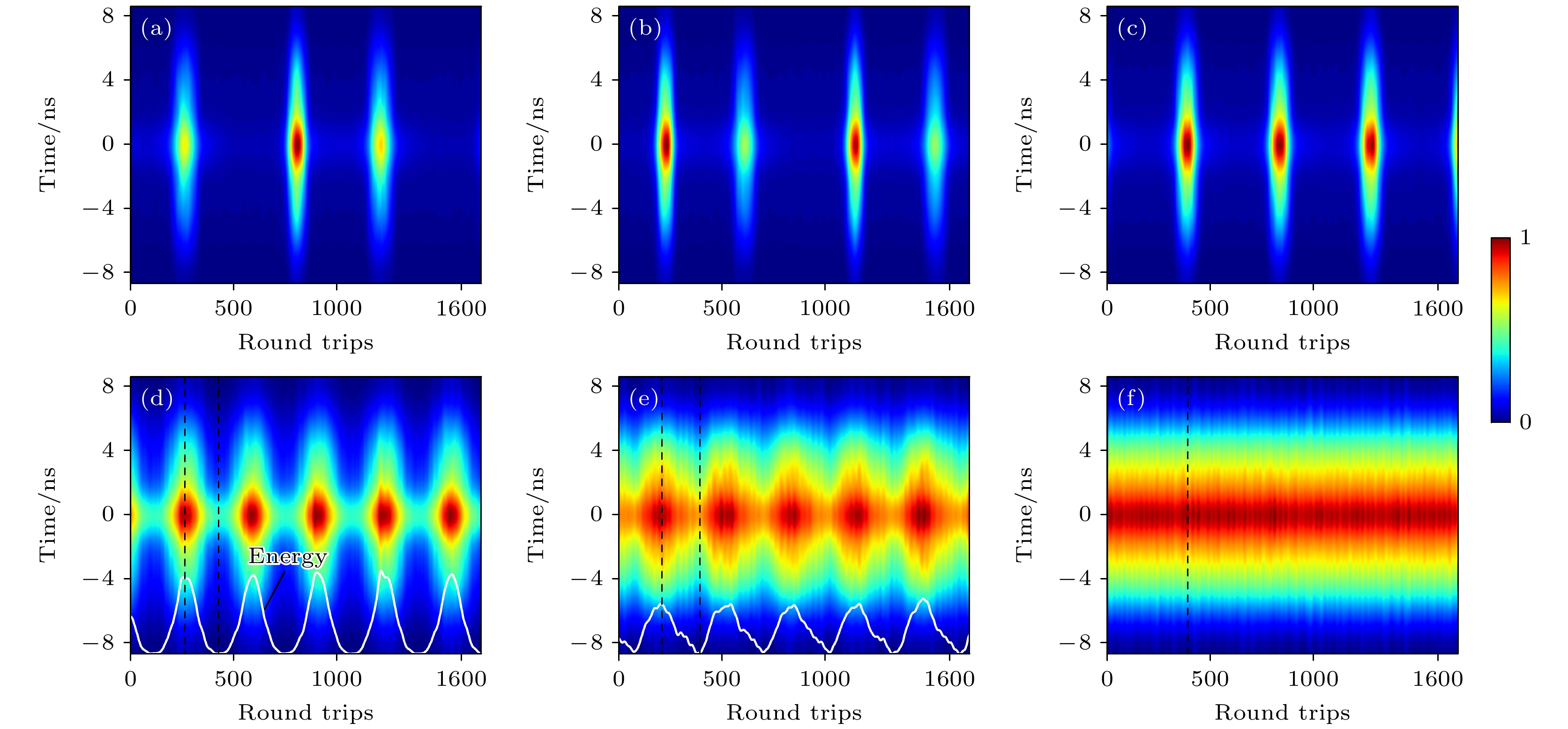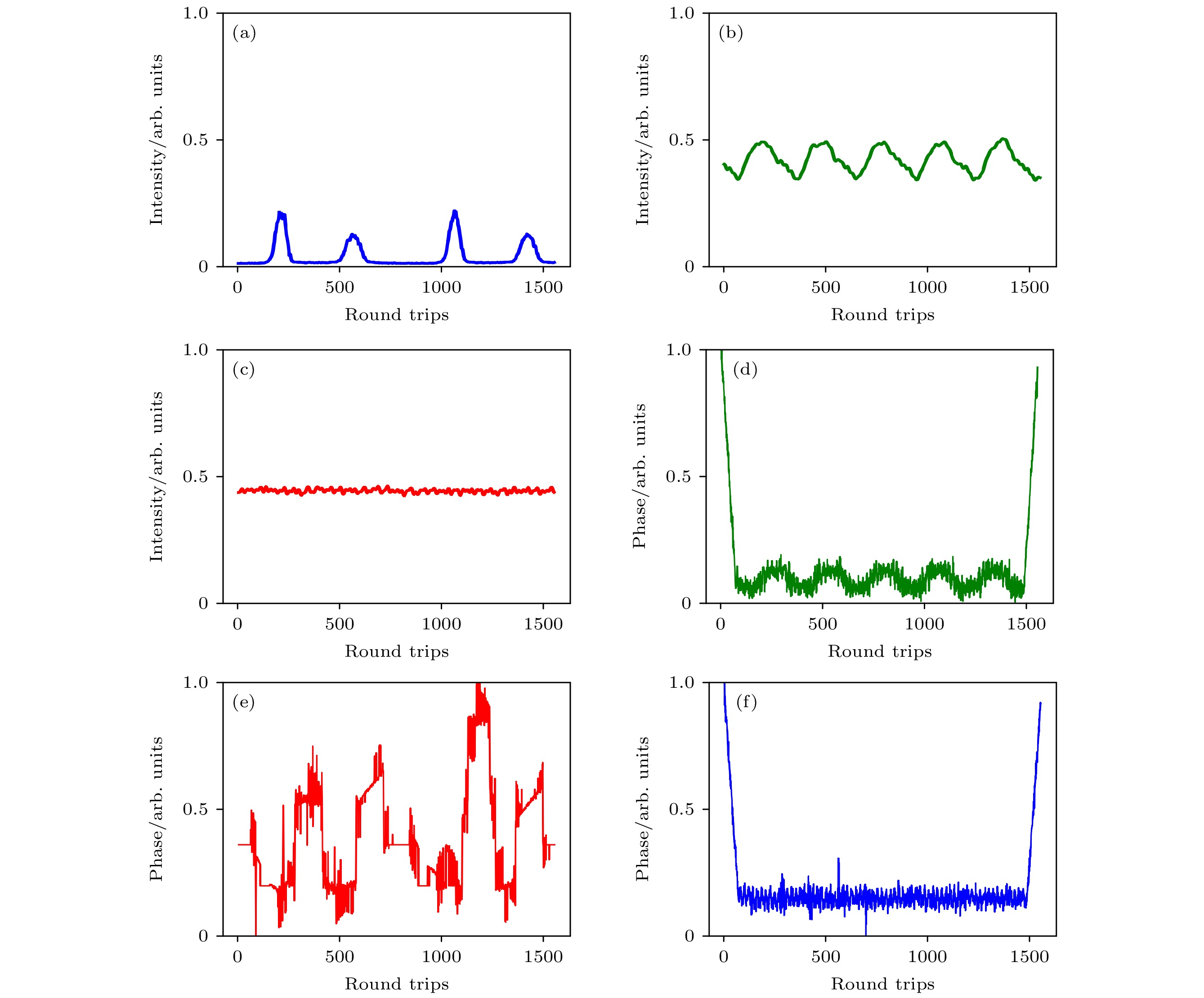-
呼吸子作为一种独特的非线性脉冲现象, 在激光器性能优化、非线性光学过程研究以及复杂信号传输中发挥着关键作用. 与稳定孤子不同, 呼吸子脉冲的能量随着时间发生周期性波动, 表现为脉冲频率和振幅的周期性变化. 通过适当的非线性效应, 激光器能够产生稳定的呼吸子脉冲, 实现呼吸锁模状态, 展现出类似“呼吸”的周期性模式. 基于此, 本文设计并搭建了一台基于可饱和吸收体作为锁模元件的光纤激光器, 并在较低泵浦功率下成功观察到稳定的呼吸态. 通过利用高速探测技术和时间拉伸色散傅里叶变换(TS-DFT)技术, 对快速脉冲进行了时间放大和频谱分析, 并实时监测呼吸子脉冲在时域和频域上的演化过程. 实验结果表明, 泵浦功率的变化显著地影响附加振荡引发的周期性调制, 从而调控呼吸比, 直至形成稳定的孤子. 当泵浦功率达到470—480 mW时, 实验首次观察到呼吸子的形成, 其呼吸比高达4.5. 随着泵浦功率的增加, 呼吸效应逐渐减弱, 并在510 mW时完全消失, 呼吸比降至1. 这一结果验证了泵浦功率对呼吸子状态及其转变过程的关键控制作用, 为超快激光技术和非线性光学领域提供新视角.
Breathing pulses, as a unique nonlinear pulse phenomenon, play a key role in optimizing laser performance, nonlinear optical processes, and complex signal transmission. Unlike stable solitons, the breathing pulses fluctuates in energy periodically with time, and both pulse frequency and amplitude exhibit periodic changes. Through appropriate nonlinear effects, lasers can generate stable breathing pulses, achieving a mode-locked state that exhibits a periodic “breathing” pattern. Based on this, a fiber laser combining a saturable absorber as the mode-locking element is designed and built, and stable breathing states are successfully observed at lower pump power levels. High-speed detection techniques and time-stretched dispersive Fourier transform (TS-DFT) technology are used to time-amplify and spectrally analyze the rapid pulses, while monitoring the evolution of the breathing pulse in both time domain and frequency domain. Experimental results indicate that the change in pump power significantly affects the periodic modulation induced by additional oscillations, thereby controlling the breathing ratio and ultimately resulting in the formation of a stable soliton. When the pump power is between 470 and 480 mW, the formation of the breathing pulse is first observed, with a breathing ratio of up to 4.5. As the pump power increases, the breathing effect gradually diminishes, and at 510 mW, it completely disappears, with the breathing ratio dropping to 1. These results confirm the critical role of pump power in controlling the breathing pulse state and its transition, demonstrating the potential of controlling pump power in ultrafast laser technology and nonlinear optics. The breathing pulse phenomenon, as a periodic pulse behavior, reflects the complex dynamical characteristics between nonlinear optical effects and cavity parameters. Combined with the natural synchronization system formed between the breathing frequency and the cavity frequency (determined by the cavity length), the periodic change of the breathing pulse becomes a crucial factor for controlling laser output. By adjusting parameters such as the laser’s nonlinearity and dissipation, the characteristics of the breathing pulse and breathing ratio can be precisely controlled, thus achieving precise control of the laser output. The periodic oscillatory characteristics of the breathing pulse inside the laser cavity lead to the non-uniform distribution of pulses, a feature that demonstrates enormous potential in pulse shaping, ultrashort pulse generation, and precise frequency comb control. Additionally, the presence of the breathing pulse may affect the stability and energy conversion efficiency of the laser, providing new perspectives for designing and optimizing lasers. -
Keywords:
- laser /
- breather /
- nonlinear fiber dynamics
[1] Ma Q Y, Yu H Y 2023 Nanomanuf. Metrol. 6 36
 Google Scholar
Google Scholar
[2] Li Z X, Cao H Y, Wang Y Y, Dai C Q 2023 IEEE J. Sel. Top. Quantum Electron. 29 1100108
 Google Scholar
Google Scholar
[3] Shimizu Y 2021 Nanomanuf. Metrol. 4 3
 Google Scholar
Google Scholar
[4] Murakoshi H, Ueda H H, Goto R, Hamada K, Nagasawa Y, Fuji T 2023 Biomed. Opt. Express 14 326
 Google Scholar
Google Scholar
[5] Liu F, Zhang Y, Wu X D, Li J F, Yan F, Li X H 2020 IEEE Photonics J. 12 1500910
 Google Scholar
Google Scholar
[6] Keller U 2003 Nature 424 831
 Google Scholar
Google Scholar
[7] Matniyaz T, Kong F, Kalichevsky-Dong M T, Dong L 2020 Opt. Lett. 45 2910
 Google Scholar
Google Scholar
[8] 王慧慧, 郭睿 2019 应用数学进展 8 2084
 Google Scholar
Google Scholar
Wang H H, Guo R 2019 Adv. Appl. Math. 8 2084
 Google Scholar
Google Scholar
[9] Chen T, Zhang Q L, Zhang Y P, Li X, Zhang H K, Xia W 2018 Photonics Res. 6 1033
 Google Scholar
Google Scholar
[10] Liu X M 2011 Phys. Rev. A 84 053828
 Google Scholar
Google Scholar
[11] Wu X Q, Peng J S, Boscolo S, Finot C, Zeng H P 2023 Phys. Rev. Lett. 131 263802
 Google Scholar
Google Scholar
[12] Cui Y D, Zhang Y S, Huang L, Zhang A G, Liu Z M, Kuang C F, Tao C N, Chen D R, Liu X, Malomed B A 2023 Phys. Rev. Lett. 130 153801
 Google Scholar
Google Scholar
[13] 吴修齐, 彭俊松, 张颖, 曾和平 2023 中国激光 50 1101006
 Google Scholar
Google Scholar
Wu X Q, Peng J S, Zhang Y, Zeng H P 2023 Chin. J. Lasers 50 1101006
 Google Scholar
Google Scholar
[14] Grelu P, Akhmediev N 2012 Nat. Photonics 6 84
 Google Scholar
Google Scholar
[15] Guo W Q, Zhang L, Xiao X S, Li X X, Yin Z G, Ning H, Zhang X, Zhang X W 2023 Photonics 10 610
 Google Scholar
Google Scholar
[16] Xian T H, Zhan L, Wang W C, Zhang W Y 2020 Phys. Rev. Lett. 125 163901
 Google Scholar
Google Scholar
[17] Peng J S, Boscolo S, Zhao Z, Zeng H P 2019 Sci. Adv. 5 11
 Google Scholar
Google Scholar
[18] Herink G, Kurtz F, Jalali B, Solli D R, Ropers C 2017 Science 356 50
 Google Scholar
Google Scholar
[19] Apicella B, Bruno A, Wang X, Spinelli N 2013 Int. J. Mass Spectrom. 338 30
 Google Scholar
Google Scholar
[20] Cui Y D, Zhang Y S, Song Y J, Tong L, Huang L, Qiu J R, Liu X M 2021 Laser Photonics Rev. 15 2000216
 Google Scholar
Google Scholar
[21] Lucas E, Karpov M, Guo H, Gorodetsky M L, Kippenberg T J 2017 Nat. Commun. 8 736
 Google Scholar
Google Scholar
[22] Qin Z P, Xie G Q, Gu H A, Hai T, Yuan P, Ma J G, Qian L J 2019 Adv. Photonics 1 065001
 Google Scholar
Google Scholar
[23] Auer G, Dammann A, Sand S 2003 Proceedings of the 14th IEEE International Symposium on Personal, Indoor and Mobile Radio Communications Beijing, China, September 7–10, 2003 pp1954–1958
[24] Schafer R W 2011 IEEE Signal Process. Mag. 28 111
 Google Scholar
Google Scholar
[25] 黄旭方, 陈静开, 覃新贤 2012 电讯技术 52 1893
 Google Scholar
Google Scholar
Huang X F, Chen J K, Qin X X 2012 Telecommun. Eng. 52 1893
 Google Scholar
Google Scholar
[26] Woodward R I, Kelleher E J R 2015 Appl. Sci. 5 1440
 Google Scholar
Google Scholar
[27] 江俊林, 乐文杰, 王玮琦, 丁翌辰, 吴波, 沈永行 2018 光子学报 47 0914001
 Google Scholar
Google Scholar
Jiang J L, Le W J, Wang W Q, Ding Y C, Wu B, Shen Y X 2018 Acta Photonica Sin. 47 0914001
 Google Scholar
Google Scholar
[28] Hu F T, Vinod A K, Wang W, Chin H H, McMillan J F, Zhan Z Y, Meng Y, Gong M, Wong C W 2024 Light Sci. Appl. 13 251
 Google Scholar
Google Scholar
-
图 2 (a) 每个单次激发光谱的傅里叶变换; (b) 时间平均自相关宽度的测量结果; (c) 一个振荡周期内最大往返次数与最小往返次数单激发光谱; (d) 频谱特征; (e) 示波器记录的实验测量脉冲序列
Fig. 2. (a) Fourier transform of each single excitation spectrum; (b) measurement of time-averaged autocorrelation width; (c) the maximum and minimum round-trip numbers within one oscillation period of a single-excitation spectrum; (d) spectral characteristics; (e) experimental measurement pulse sequences recorded by an oscilloscope.
图 3 呼吸子在470—510 mW泵浦功率范围内的高速动力学演化过程及其相对于1600次连续往返的时域演化 (a) Pp=470 mW; (b) Pp = 480 mW; (c) Pp = 490 mW; (d) Pp = 500 mW; (e) Pp = 506 mW; (d) Pp = 510 mW
Fig. 3. The high-speed dynamical evolution of the breath pulse in the pump power range from 470 to 510 mW, and its temporal evolution relative to 1600 continuous round trips: (a) Pp = 470 mW; (b) Pp = 480 mW; (c) Pp = 490 mW; (d) Pp = 500 mW; (e) Pp = 506 mW; (f) Pp = 510 mW.
图 4 (a), (d) Pp = 480 mW未形成呼吸子状态下的脉冲强度和相位变化; (b), (e) Pp = 506 mW呼吸子稳定状态的脉冲强度和相位变化; (c), (f) Pp = 510 mW孤子状态下的脉冲强度和相位变化
Fig. 4. (a), (d) The pulse intensity and phase variations at Pp = 480 mW in the non-breather state; (b), (e) the pulse intensity and phase variations at Pp = 506 mW in the stable breather state; (c), (f) the pulse intensity and phase variations at Pp = 510 mW in the soliton state.
-
[1] Ma Q Y, Yu H Y 2023 Nanomanuf. Metrol. 6 36
 Google Scholar
Google Scholar
[2] Li Z X, Cao H Y, Wang Y Y, Dai C Q 2023 IEEE J. Sel. Top. Quantum Electron. 29 1100108
 Google Scholar
Google Scholar
[3] Shimizu Y 2021 Nanomanuf. Metrol. 4 3
 Google Scholar
Google Scholar
[4] Murakoshi H, Ueda H H, Goto R, Hamada K, Nagasawa Y, Fuji T 2023 Biomed. Opt. Express 14 326
 Google Scholar
Google Scholar
[5] Liu F, Zhang Y, Wu X D, Li J F, Yan F, Li X H 2020 IEEE Photonics J. 12 1500910
 Google Scholar
Google Scholar
[6] Keller U 2003 Nature 424 831
 Google Scholar
Google Scholar
[7] Matniyaz T, Kong F, Kalichevsky-Dong M T, Dong L 2020 Opt. Lett. 45 2910
 Google Scholar
Google Scholar
[8] 王慧慧, 郭睿 2019 应用数学进展 8 2084
 Google Scholar
Google Scholar
Wang H H, Guo R 2019 Adv. Appl. Math. 8 2084
 Google Scholar
Google Scholar
[9] Chen T, Zhang Q L, Zhang Y P, Li X, Zhang H K, Xia W 2018 Photonics Res. 6 1033
 Google Scholar
Google Scholar
[10] Liu X M 2011 Phys. Rev. A 84 053828
 Google Scholar
Google Scholar
[11] Wu X Q, Peng J S, Boscolo S, Finot C, Zeng H P 2023 Phys. Rev. Lett. 131 263802
 Google Scholar
Google Scholar
[12] Cui Y D, Zhang Y S, Huang L, Zhang A G, Liu Z M, Kuang C F, Tao C N, Chen D R, Liu X, Malomed B A 2023 Phys. Rev. Lett. 130 153801
 Google Scholar
Google Scholar
[13] 吴修齐, 彭俊松, 张颖, 曾和平 2023 中国激光 50 1101006
 Google Scholar
Google Scholar
Wu X Q, Peng J S, Zhang Y, Zeng H P 2023 Chin. J. Lasers 50 1101006
 Google Scholar
Google Scholar
[14] Grelu P, Akhmediev N 2012 Nat. Photonics 6 84
 Google Scholar
Google Scholar
[15] Guo W Q, Zhang L, Xiao X S, Li X X, Yin Z G, Ning H, Zhang X, Zhang X W 2023 Photonics 10 610
 Google Scholar
Google Scholar
[16] Xian T H, Zhan L, Wang W C, Zhang W Y 2020 Phys. Rev. Lett. 125 163901
 Google Scholar
Google Scholar
[17] Peng J S, Boscolo S, Zhao Z, Zeng H P 2019 Sci. Adv. 5 11
 Google Scholar
Google Scholar
[18] Herink G, Kurtz F, Jalali B, Solli D R, Ropers C 2017 Science 356 50
 Google Scholar
Google Scholar
[19] Apicella B, Bruno A, Wang X, Spinelli N 2013 Int. J. Mass Spectrom. 338 30
 Google Scholar
Google Scholar
[20] Cui Y D, Zhang Y S, Song Y J, Tong L, Huang L, Qiu J R, Liu X M 2021 Laser Photonics Rev. 15 2000216
 Google Scholar
Google Scholar
[21] Lucas E, Karpov M, Guo H, Gorodetsky M L, Kippenberg T J 2017 Nat. Commun. 8 736
 Google Scholar
Google Scholar
[22] Qin Z P, Xie G Q, Gu H A, Hai T, Yuan P, Ma J G, Qian L J 2019 Adv. Photonics 1 065001
 Google Scholar
Google Scholar
[23] Auer G, Dammann A, Sand S 2003 Proceedings of the 14th IEEE International Symposium on Personal, Indoor and Mobile Radio Communications Beijing, China, September 7–10, 2003 pp1954–1958
[24] Schafer R W 2011 IEEE Signal Process. Mag. 28 111
 Google Scholar
Google Scholar
[25] 黄旭方, 陈静开, 覃新贤 2012 电讯技术 52 1893
 Google Scholar
Google Scholar
Huang X F, Chen J K, Qin X X 2012 Telecommun. Eng. 52 1893
 Google Scholar
Google Scholar
[26] Woodward R I, Kelleher E J R 2015 Appl. Sci. 5 1440
 Google Scholar
Google Scholar
[27] 江俊林, 乐文杰, 王玮琦, 丁翌辰, 吴波, 沈永行 2018 光子学报 47 0914001
 Google Scholar
Google Scholar
Jiang J L, Le W J, Wang W Q, Ding Y C, Wu B, Shen Y X 2018 Acta Photonica Sin. 47 0914001
 Google Scholar
Google Scholar
[28] Hu F T, Vinod A K, Wang W, Chin H H, McMillan J F, Zhan Z Y, Meng Y, Gong M, Wong C W 2024 Light Sci. Appl. 13 251
 Google Scholar
Google Scholar
计量
- 文章访问数: 3212
- PDF下载量: 105
- 被引次数: 0














 下载:
下载:



